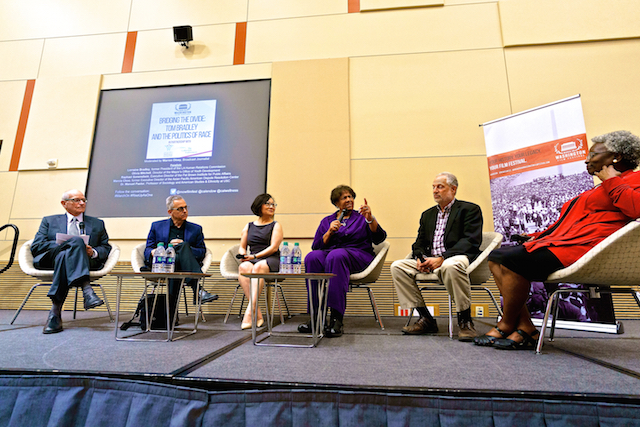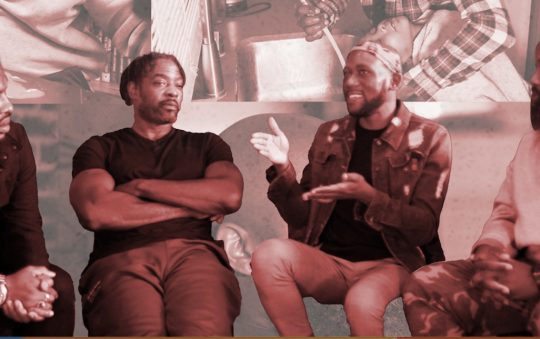
Long before the election of America’s 44th President Barack Obama, former Los Angeles Mayor Tom Bradley did something unprecedented. Bradley and his supporters formed a multi-racial coalition to win an election in a major American city. After winning the election, Los Angeles Mayor Thomas J. “Tom” Bradley, the first African-American to helm a majority white population, redefined the dialogue of race.
Last week, The California Endowment hosted a screening of “Bridging the Divide: Tom Bradley and the Politics of Race”, a penetrating documentary produced and directed by researcher Alison Sotomayor and documentarian, Lyn Goldfarb. “Yes, a Jew and a Latina told a black story,” expressed Sotomayor. “We honestly thought this would be an easy story to tell, an easy film to make. We’re both from L.A. and knew what kind of impact Bradley made on us. Eight years later, this film has been the hardest challenge I’ve ever overcome because of the fundraising. Tom Bradley is not in our history books, which meant that he had become marginalized.”
The two women tell the little-known story of Bradley, who was a son of two sharecroppers and the grandson of a slave who went on to hold the office of L.A.’s mayor for over 20 years. Sotomayor and Goldfarb met while working on another documentary called, “The New Los Angeles”. “The New Los Angeles” covers the period of Bradley’s election as mayor in 1973, and both women were struck by the fact that no one had ever documented Bradley’s historic entry and advancement into the political realm. “Tom Bradley’s legacy was being forgotten and it was being distorted,” says Sotomayor. “So, we came together and said it’s a story that needs to be done. And also, not just for the masses, but it’s very important for Lyn and I to be able to push this film to the next generation.”

In 1973, the question of races coming together to face the challenges of a dominant city like L.A. was revolutionary. In the documentary, we follow Bradley as he uses previous “Coalition-building campaign strategies” used before by other campaigns (of civil rights, Mayor Sam Yorty) before him to succeed.
“Bridging the Divide: Tom Bradley and the Politics of Race” opens with the 1965 Watts Riots and the chaotic remains of its destruction. We are introduced to Tom Bradley and his family once they moved from Texas to Los Angeles, where Tom thrived. First, as an athlete at UCLA and then in a racially charged L.A .Police Department, Bradley was motivated to make a difference in the way Blacks were treated. As a Lieutenant, Bradley would be the first Black officer to lead a team of White officers. After getting his law degree, he ran an unsuccessful mayoral run in 1969 and ran a second time in 1973 by partnering with the Jewish, Hispanic and Asian communities. “This city is ready not for a Black man, not for a Red man, not for a Yellow man, not for a White man; it’s ready for the best man—and that is Tom Bradley!” The documentary featured 40 of the 100 interviews done to explain the full story of Tom Bradley. Included were former congressman and Atlanta mayor Andrew Young, former LAPD officer, Felix Bell, Rev. Cecil L. Murray of FAME Church, Bradley’s daughter Lorraine Bradley; former LAPD chief and L.A. City Councilman Bernard Parks and actor George Takei, among others.
“What Tom Bradley showed us, was that you could reach out to people who are different than you: different race, different ethnicities, different backgrounds, and that together, if you come together, you can accomplish something much greater,” said Goldfarb.
After the screening, a panel discussed their thoughts of the film and Bradley’s influence. Included in the conversation were journalist, Warren Olney, professor of Sociology and American Studies & Ethnicity at USC, Dr. Manuel Pastor, executive director of the Asian Pacific American Dispute Resolution Center, Marcia Choo, Bradley’s daughter, Lorraine Bradley, executive director of the Pat Brown Institute of Public Affairs, Raphael Sonenshein and director of Mayor’s Office of Youth Development, Olivia Mitchell. “It was difficult for an African American to be in the position of power and many just weren’t and still aren’t ready for it, believes Lorraine Bradley. “After you see this film, I hope that people who might maybe think that there is no hope for them or they think maybe they don’t have a chance to make it better. Here, it was proved in 1973.”







